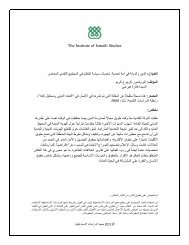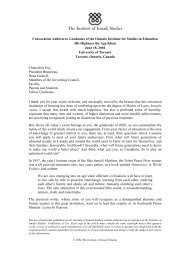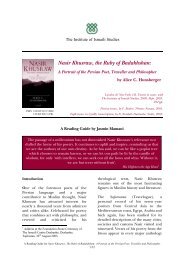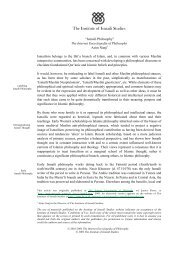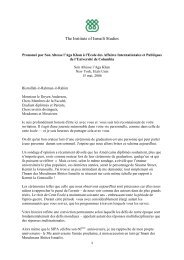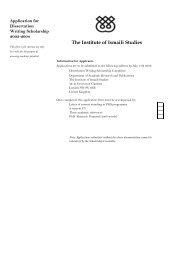The Institute of Ismaili Studies 1
The Institute of Ismaili Studies 1
The Institute of Ismaili Studies 1
Create successful ePaper yourself
Turn your PDF publications into a flip-book with our unique Google optimized e-Paper software.
On the death <strong>of</strong> the twenty-sixth da‘i mutlaq, Da’ud b. ‘Ajabshah, in 997 AH/1589 CE, his succession<br />
was disputed, leading to the Da’udi-Sulaymani schism in the Tayyibi da‘wa and community. <strong>The</strong><br />
great majority <strong>of</strong> Tayyibis, then located in India, acknowledged Da’ud Burhan al-Din (d. 1021<br />
AH/1612 CE) as their new da‘i and became known as Da’udis. A small number <strong>of</strong> Yemeni Tayyibis,<br />
too, supported the Da’udi cause. On the other hand, a minority <strong>of</strong> all Tayyibis, who accounted for the<br />
bulk <strong>of</strong> the community in Yemen, recognised Sulayman b. Hasan (d. 1005 AH/ 1597 CE) as their<br />
new, twenty-seventh da‘i; they became known as Sulaymanis. Henceforth, the Da’udi and Sulaymani<br />
Tayyibis followed separate lines <strong>of</strong> da‘is. <strong>The</strong> Da’udi da‘is continued to reside in India, while the<br />
headquarters <strong>of</strong> the Sulaymani da‘wa were established in Yemen (Muhammad ‘Ali, Mawsem-e bahar,<br />
III, pp. 169-259; Misra, pp. 27-31; Daftary, 1990, pp. 299-306). Subsequently, the Da’udi Bohras<br />
were further subdivided in India due to periodical challenges to the authority <strong>of</strong> their da‘i mutlaq.<br />
In 1200 AH/1785 CE, the headquarters <strong>of</strong> the Da’udi da‘wa was transferred to Surat, where the fortythird<br />
da‘i, ‘Abd ‘Ali Sayf al-Din (1213-32 AH/1798-1817 CE), founded a seminary known as Sayfi<br />
Dars, also Jami‘a Sayfia, for the education <strong>of</strong> Da’udi scholars and the functionaries <strong>of</strong> the community.<br />
This seminary, with a major library, has continued to serve as an institution <strong>of</strong> traditional Islamic<br />
learning for the Da’udi Bohras. Since 1232 AH/1817 CE, the <strong>of</strong>fice <strong>of</strong> the da‘i mutlaq <strong>of</strong> the Da’udi<br />
Tayyibis has remained among the descendants <strong>of</strong> Shaykh Jiwanji Awrangabadi, while the community<br />
has experienced intermittent strife and crisis rooted in opposition to the da‘i’s authority. <strong>The</strong> present<br />
da‘i mutlaq <strong>of</strong> the Da’udi da‘wa, Sayyidna Burhan al-Din, succeeded to his position as the fifty<br />
second in the series in 1385 AH/1965 CE. <strong>The</strong> total Da’udi population <strong>of</strong> the world is currently<br />
(2002) estimated at around 900,000, located mainly in South Asia. Since the 1920s, Bombay, with its<br />
largest single concentration <strong>of</strong> Da’udi Bohras, has served as the permanent administrative seat <strong>of</strong> the<br />
Da’udi da‘i mutlaq. <strong>The</strong> Tayyibi Bohras, together with the Nizari Khojas, were also among the<br />
earliest Asian communities to settle, during the nineteenth century and subsequently, in East Africa<br />
(Amiji, 1969, pp. 141-81; — —, 1975, pp. 27-61).<br />
In Yemen, the leadership <strong>of</strong> the Sulaymani Tayyibis has remained hereditary, since 1088 AH/1677<br />
CE, with few exceptions, in the same Makrami family. Unlike the Da’udis, the Sulaymanis have not<br />
experienced succession disputes and schisms. <strong>The</strong> Sulaymani da‘is established their headquarters in<br />
Najran, in northeastern Yemen, and ruled over that region with the military support <strong>of</strong> the local Banu<br />
Yam. In the twentieth century, the political prominence <strong>of</strong> the Sulaymani da‘is, checked earlier by the<br />
Ottomans, was further curtailed by the Sa‘udi family; Najran was, in fact, annexed to Saudi Arabia in<br />
1353 AH/1934 CE. <strong>The</strong> present da‘i mutlaq <strong>of</strong> the Sulaymanis, the forty-ninth in the series, Sayyidna<br />
Sarafi Husayn Makrami who succeeded to <strong>of</strong>fice in 1396 AH/1976 CE, lives in Saudi Arabia. At<br />
present, the Sulaymani Tayyibi <strong>Ismaili</strong>s <strong>of</strong> Yemen number around 70,000 persons. <strong>The</strong> Sulaymani<br />
Bohras represent a very small community <strong>of</strong> a few thousands in India (Daftary, 1990, pp. 318-23).<br />
Nizari Ismalism <strong>of</strong> the Alamut Period<br />
By 487 AH/1094 CE, Hasan-i Sabbah, who preached the <strong>Ismaili</strong> da‘wa on behalf <strong>of</strong> the Fatimids<br />
within the Saljuq dominions in Persia, had emerged as the leader <strong>of</strong> the Persian <strong>Ismaili</strong>s. He had<br />
already been following an independent policy, and his seizure <strong>of</strong> the mountain fortress <strong>of</strong> Alamut in<br />
483 AH/1090 CE signalled the commencement <strong>of</strong> an open revolt against the Saljuq Turks as well as<br />
the foundation <strong>of</strong> what was to become the Nizari <strong>Ismaili</strong> state. As an <strong>Ismaili</strong> Shi‘i, Hasan-i Sabbah<br />
could not have tolerated the anti-Shi‘i policies <strong>of</strong> the Saljuqs, who as the new champions <strong>of</strong> Sunni<br />
Islam aimed to uproot the Fatimids. Hasan’s revolt was also an expression <strong>of</strong> Persian “national”<br />
sentiments, as the alien rule <strong>of</strong> the Saljuq Turks was intensely detested by the Persians <strong>of</strong> different<br />
…Please see copyright restrictions on page 1<br />
13



